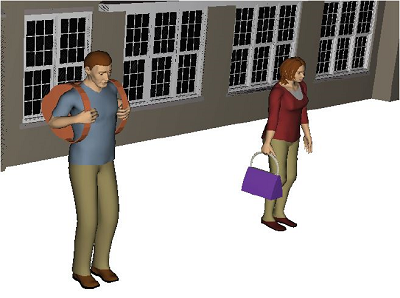University uses human modeling and simulation in undergraduate research studies.

Jack software supports ergonomics research and education at Penn State Behrend
Ergonomics, the study of the relationship between people and their work environment, is vital to workplace safety and health and is also an essential element to product design and development. In an ever-competitive climate, aligning product design and manufacturing education with market needs is essential to overcome the skills gap and other challenges faced by undergraduate and graduate students. As a result, students need to understand the principles of ergonomics as it is increasingly becoming an integral part of product design, manufacturing and use.
Recent advancements in computer technology over the last two decades have contributed to the development of computer simulations for ergonomics. Such simulations are known as digital human modeling (DHM) and are used to assess the performance of human operators in the workplace. DHM can also be integrated with computer-aided design (CAD) to evaluate the ergonomics of product design.
Many studies have been conducted over the last 30 years emphasizing the importance of applying ergonomic principles to product designs for many high-use products such as swimming suits, non-powered hand tools, writing instruments for children and luggage handles. Thus, continuously interjecting human factors and ergonomic (HFE) design concepts in any undergraduate engineering design curriculum is important.
Ergonomic research at Penn State Behrend
Studies have found that 19 percent of industrial engineering students are capable of adequately assessing ergonomic risks throughout their undergraduate program. Recent studies conducted at Penn State Behrend focused on product design in the context of business challenges. In these studies, students did not design products but instead analyzed existing products with the aid of Siemens PLM Software’s Jack™ software in the Tecnomatix® portfolio. Jack software is a premier human simulation tool for populating designs with virtual people and performing human factors and ergonomic analysis.
 Manual pipette design evaluation.
Manual pipette design evaluation.
Improving ergonomics of pipettes
The frequent use of pipettes is a common cause of musculoskeletal disorders, which include carpal tunnel syndrome, tendonitis, trigger finger and tension neck syndrome. Pipetting work requires concentration, accuracy and precision. This job can be stressful to workers, which can influence their comfort and ease of use and may affect the risk of upper limb problems.
Mechanical pipettes are used in research and clinical laboratories to dispense measured volumes of liquids. The single-channel pipette has external and internal components. The external components include the piston, the piston spring and the compression set. Pipettes most commonly work by creating a partial vacuum above the chamber that holds the liquid and selectively releasing this vacuum to draw up and disperse according to the preferred volume. They enable sterile and accurate liquid handling and are commonly used within molecular biology, analytical chemistry and medical tests. Dozens of manufacturers produce pipettes, including leading companies such as The Pipette Company, HTL Lab Solutions, ThermoFisher Scientific and Oxford.
In a recent Penn State Behrend research project, students were given two pipettes and asked to redesign them while taking into account ergonomic considerations. The process consisted of selecting the product, identifying customer requirements, translating requirements into specifications, generating and evaluating design concepts, selecting the best design and developing a CAD model and evaluating the selected design using DHM.
Several requirements were considered to ergonomically design the pipette, including: light weight; comfortable to hold; good grip; no sharp edges or ridges; positive feedback from button operation; suitable for right- or left-handed use; easy tip ejection and fitting; minimal force to push the plunger; and easy to set and read dosage. In the case study, a pinch gauge measured the ejection and push forces. The maximum forces were considered in the digital human modeling assessment. Manual sketches for the redesigned pipettes were created and evaluated, then CAD designs were developed using Autodesk Inventor® software.
The students used Jack software to evaluate the designs, conducting several simulation experiments while statistically analyzing the results. The students considered factors such as human physical characteristics, including the weights and heights of students (percentiles); the design concept; and gender of the user. A general factorial design experiment was developed and simulation runs were conducted using Jack software. It was found the three primary factors were gender, percentile and design concept.
 Ergonomic assessment of snow shovel.
Ergonomic assessment of snow shovel.
Assessing ergonomics of a snow shovel
Snow shovelling can cause ergonomic risks to the back and shoulders and can result in musculoskeletal disorders (MSDs). The design of snow shovels can and should make snow removal easier and less strenuous. In another recent Penn State Behrend case study, students used DHM to assess the ergonomic risks associated with the snow shovelling process.
Several designs for the shovels were created using CAD software. Using statistical analysis the students examined the different factors associated with the shovelling process including shovel design, gender and body mass index (BMI). The results provided recommendations for avoiding ergonomic risks and selecting the proper snow shovels.
Four common designs for snow shovels were evaluated using DHM. First, Penn State Behrend created CAD models for the four designs – basic, handle-in-shaft, bent-shaft, and two-handle shaft – using Autodesk Inventor software. Then they imported the four designs into Jack DHM software and performed analyses to evaluate the designs, using the software’s multiple options for ergonomic assessment and analysis. Jack software includes anthropometric databases that the students used to study the ergonomics of different populations.
The studies considered human physical characteristics (including the height and weight of students in percentiles, design concept, and gender. A general factorial design experiment was developed. The study showed that bent-shaft shovel design is superior because it produces lower compression force on the lower back.
 Backpack ergonomic assessment.
Backpack ergonomic assessment.
Researching backpack carriage of high school students
There are many factors that determine what qualifies as an ergonomic backpack, but it can be defined as the “spine-friendliness bag.” Ergonomically unsuited bags tend to cause spine and bone structure-based dysfunctionalities, especially on the average high school student’s fast-developing skeleton. High school students often choose their own bags based primarily on style and do not consider comfort or the potential for future back pain. This factor, combined with parents’ ignorance or indifference about backpack ergonomics, plays a large role in the origin of many spinal problems.
Penn State Behrend assessed the ergonomic risks among high school students in a local school district. The research included a survey with 21 different questions under three categories: human physical characteristics, health history, and school and backpack information. DMH simulations were created to assess the impact of factors such as backpack weight, carrying position and human physical characteristics. The results provide recommendations for avoiding ergonomic risks caused by carrying backpacks among high school students.
Penn State Behrend students considered different bag designs and created a virtual human in Jack software. The simulation environment consisted of a student (digital human) walking in school while carrying a backpack. Four bag designs were considered: handbag, shoulder bag, backpack and rolling backpack. The research determined that students used different bag types to carry their books to school. However, based on the survey results, students only used the two-strap bag. The angles of the forces caused by the backpack weight on the human shoulders and back were assumed to be equivalent to the weight of the bag, two on the shoulders and one on the back.
To identify the risk factors associated with carrying backpacks, the research study included several simulation experiments and statistical analysis of the results. The research considered human physical characteristics (including the height and weight of students), the weight of the bag and gender. Simulation runs were conducted in Jack software. It was found that gender and bag weight are the most significant factors in determining the risk associated with carrying backpacks.
A key tool for ergonomic assessment
Jack software was a key tool for Penn State Behrend in its ergonomic assessment case studies. Digital human modeling supports undergraduate research and education in ergonomics and manufacturing simulation. Jack software was successfully used by Penn State Behrend to study the ergonomics and identify the associated risk factors for back packs, manual pipettes and snow shovels.
Studies have found that 19 percent of industrial engineering students are capable of adequately assessing ergonomic risks throughout their undergraduate program.


![Reshaping the world with digital manufacturing [VIDEO]](https://blogs.sw.siemens.com/wp-content/uploads/sites/7/2024/07/Zvi_2024_2-395x222.png)